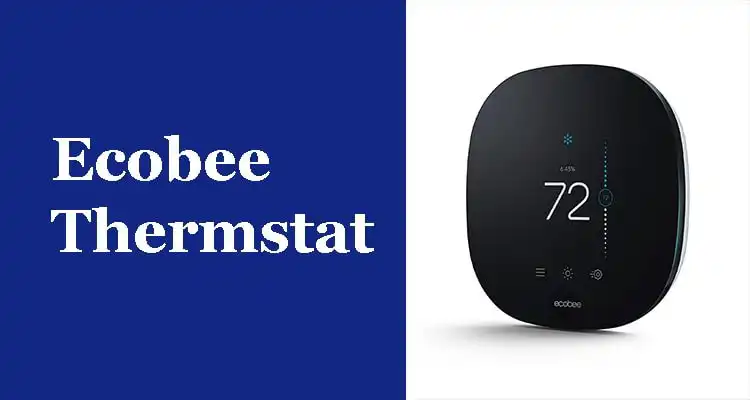Today an extremely used thermostat for HVAC systems at home is one called the Ecobee thermostat. Each of the Ecobee models has distinct advantages and features. But, as with all technologies, the Ecobee thermostat can occasionally cause difficulties. Maybe you are wondering what the most frequently encountered issues are and how simple to troubleshoot. Also, repair the issue with an Ecobee thermostat.
The most frequent issues that Ecobee thermostat users experience result from problems arising from incorrect electrical wiring or defective, excessively low voltage, tripped circuit breakers, damaged sensors, blown fuses, and overheating or improper settings. Fortunately, you can easily diagnose and also resolve most of these issues by having to call for an HVAC technician.
The article below will go over eight of the most frequently encountered issues you could face in the Ecobee thermostat. To make it easier for you I begin with a list of issues. I’ll tackle and briefly outline the potential causes of the issue. After that, I’ll address the issue in more detail and provide some suggestions for how to troubleshoot and address the issues.
What is an Ecobee Thermostat?
Ecobee is an energy-efficient smart thermostat from a company called Ecobee Inc. The Ecobee smart thermostat connects to your Wi-Fi and can be controlled from your smartphone or laptop. You can control the temperature of your home while you’re at work or while you’re asleep. Ecobee has a remote sensor that can be placed in a different room than the thermostat to help the thermostat account for the temperature in every room in your home. It also has a feature that adjusts the temperature in your home to help you save energy. Ecobee is a smart thermostat that allows you to control the temperature in your home and helps you save money.
Also, read- Aprilaire WiFi Thermostat
Troubleshooting steps of Ecobee Thermostat
Here are the troubleshooting steps for the Ecobee Thermostat.
Check the Power Supply
If you’ve hardwired your Ecobee thermostat using the C-wire. Be sure to check the power source that provides electricity through the C-wire. The transformer could fail however, don’t try to fix it yourself, as it might require higher-end DIY abilities. Have someone else look at the problem for you, and then get the transformer changed. If you’ve utilized this Power Extender kit, also make sure it’s functioning properly and that the connections are safe. If you’ve never utilized the C-wire with the ecobee make sure to examine the adapter to C-wire to see if there are any issues.
Check for a Blown Fuse
Like all HVAC equipment, the primary source of failure is the fuses in the event of an electrical problem. They are made as the primary device that fails in the event of an electrical surge. This is to safeguard you as well as your equipment. Before looking at the breaker box, make sure you’re wearing rubber gloves and boots. Be aware of live voltages coming from the mains power supply with care Turn off the circuit breaker for the whole home. Examine if the fuses connecting towards your HVAC system have blown. in the event that they are, repair them. Fuses are designed to be replaceable. simply pull the fuse that has been blown out and replace it with the new fuse.
Check if System is Set to Cool
If you’ve set the thermostat to Cool mode but there’s no change, make sure that the thermostat is set to cool mode. Utilize the Ecobee app to check whether the thermostat is in cool mode. You can also examine the display of the thermostat. If it’s not in the manner you’d like to see, turn on the model you want and change the temperature of the thermostat.
Check the wire for fraying
Wear and tear from everyday use can cause damage to or fray the thermostat’s wiring and stop it from responding to commands. Unhook the thermostat from its mounting and examine the wiring for wear or damage. Repair the wiring as needed The wiring in the mount is typically low-voltage, however, be aware while working around wires. It is also possible to inspect the wiring of your HVAC system for any damage to the wiring. If you notice the damage, I suggest you do not fix it. Instead, call an electrician or an HVAC technician to examine the area.
Check the AC’s filtering
The filters inside your HVAC system could become clogged with dust, particularly in the event that you run the AC all day. The filter is situated on the side that is used to return air from the unit. It could be located in the crawl space or the basement. Do a visual inspection on your own; leave your heavy-lifting work up to experts. Contact the HVAC technicians to inspect the filter and have it replaced if needed. I would not recommend making repairs to your filter yourself. There is a chance that you could hurt yourself doing repairs.
Check the Drain Lines
If the air is dusty in the area you live in, the drain lines, which hold the moisture inside the evaporator coils of your HVAC unit, may get blocked. The drain line draws the moisture from the system and drains it away near the outdoor unit. Also, make sure to check the drain lines to see if there are any blockages that could have occurred. Distilled vinegar can be used to cleanse the drain pipes. Pour the liquid into the drain pipe after removing it and letting it flow through all of it. Attach the drain pipe again and then test the thermostat to see if the problem is now solved.

